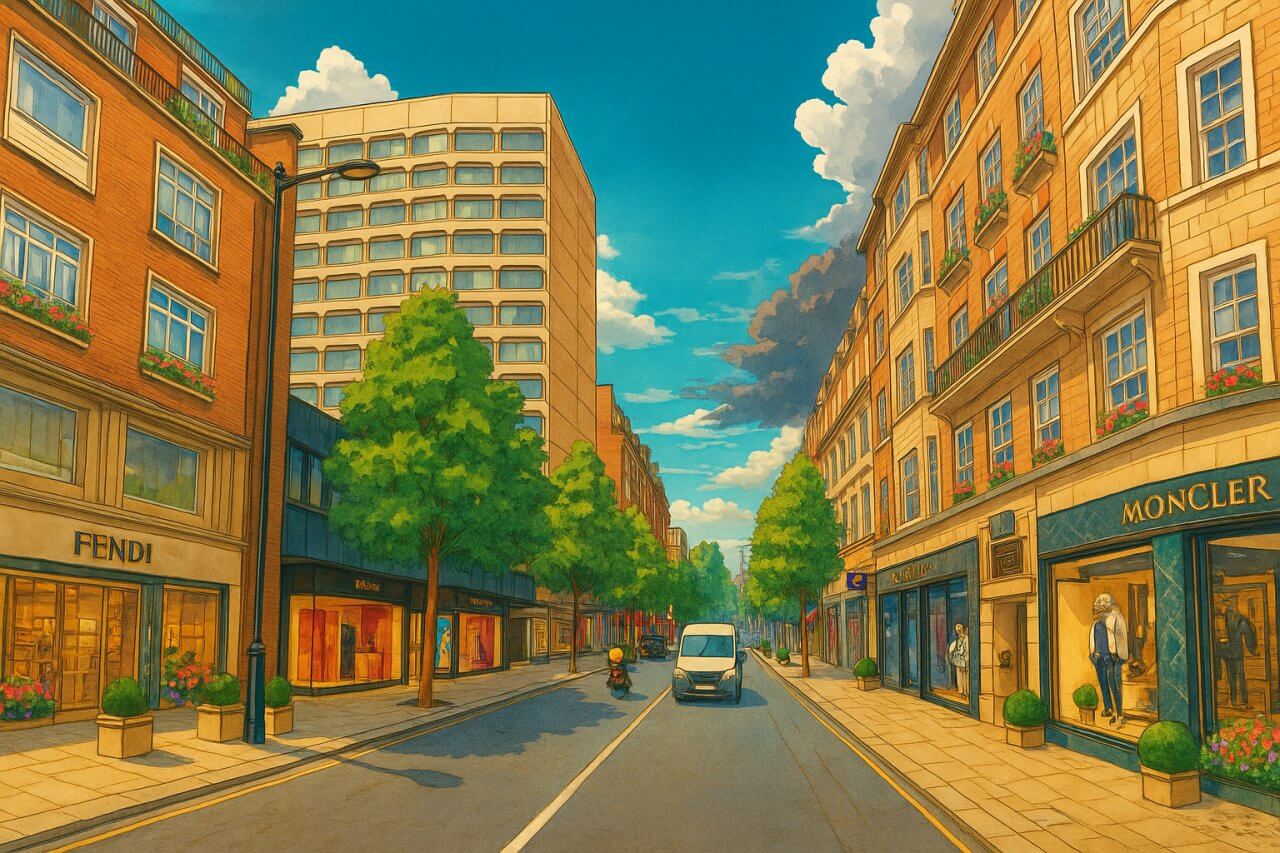
Sloane Street, London
Sloane Street is a distinguished and fashionable thoroughfare in central London, linking the upscale areas of Knightsbridge in the north with the refined Sloane Square in the south. Lined with luxury boutiques, historic townhouses, and elegant apartment buildings, it is one of the city's most prestigious addresses. Pont Street intersects it approximately midway, marking a subtle shift in architectural style and commercial tone.
Overview and Geography
Sloane Street runs in a roughly north–south orientation, stretching approximately 0.7 miles (1.1 kilometres) in length. The street lies entirely within the Royal Borough of Kensington and Chelsea. Traffic flows two-way for most of its length, accommodating both local and through-traffic. Due to its prime central location, the street is usually busy with a mix of private vehicles, taxis, and delivery vans serving the many residences and retail stores.
Streets connected to Sloane Street
- Cadogan Gardens
- Cadogan Gate
- Cadogan Place
- Ellis Street
- Hans Crescent
- Harriet Street
- Knightsbridge
- Pavilion Street
- Pont Street
- Sloane Square
- Sloane Terrace
- Wilbraham Place
History of Sloane Street
The origins of Sloane Street trace back to the 18th century, when it was laid out as a direct route connecting Knightsbridge and the developing area around Sloane Square. The street takes its name from Sir Hans Sloane (1660–1753), an eminent physician, naturalist, and collector. Sloane was the president of the Royal Society and a key figure in the foundation of the British Museum, having bequeathed his vast collections to the nation.
The name Sloane is pronounced SLOHN (IPA: /sləʊn/  ). It has been in use for the street since the 18th century, and reflects the extensive land holdings of the Cadogan Estate, heirs of Hans Sloane, who continue to own much of the land in this part of London today.
). It has been in use for the street since the 18th century, and reflects the extensive land holdings of the Cadogan Estate, heirs of Hans Sloane, who continue to own much of the land in this part of London today.
Character and Atmosphere
Sloane Street is synonymous with wealth, elegance, and exclusivity. The northern section, near Knightsbridge, is dominated by luxury fashion brands and flagship boutiques, including Chanel, Gucci, Dolce & Gabbana, and Prada, forming one of the city’s most exclusive shopping areas.
As the street progresses southward, the tone becomes more residential. Red-brick mansion blocks, white stucco townhouses, and prestigious gated apartments lend the street an air of quiet refinement. The architecture ranges from Victorian and Edwardian to more modern interpretations of classical forms.
Points of Interest and Nearby Attractions
While Sloane Street itself is a destination for high-end retail therapy, the surrounding area offers several notable attractions:
- Harrods – Just a short walk north in Knightsbridge, this iconic department store needs little introduction.
- Cadogan Place Gardens – A private garden visible from the street’s eastern side, adding greenery and serenity.
- Sloane Square – A lively public square with cafes, the Royal Court Theatre, and easy access to the King's Road.
- Holy Trinity Church, Sloane Street – An architectural gem with Arts and Crafts elements, known for its beautiful stained glass.
Real Estate and Property Values
Properties on Sloane Street are among the most expensive in London. As of early 2025, the average price for a three-bedroom flat is approximately £6.5 million. That equates to around £4,500 per square foot (£48,400 per sq metre), with penthouses and rare freehold properties commanding significantly higher premiums.
Residences here typically range from 1,200 sq ft (111 sq m) to 3,500 sq ft (325 sq m), although some multi-level homes exceed these figures. Compared to London’s average (£740/sq ft in Greater London), this represents some of the highest real estate values in the UK.
Transport Links
Underground Stations
- Knightsbridge Station (northern end) – Served by the Piccadilly Line. The entrance is close to Harrods on Brompton Road.
- Sloane Square Station (southern end) – Served by the District and Circle Lines. Conveniently located at the street’s southern junction.
Bus Services
Several Transport for London bus routes serve stops along and near Sloane Street, including:
- Route 19 – Finsbury Park to Battersea
- Route 22 – Oxford Circus to Putney Common
- Route 137 – Streatham Hill to Marble Arch
Bus stops are located at key points including Sloane Square and Knightsbridge, with additional stops near Pont Street for mid-street access.
Fun Fact
The term “Sloane Ranger” – a satirical nickname coined in the 1980s – refers to upper-class or aristocratic young women often seen around Sloane Street and Sloane Square. The term blends "Sloane" with "Lone Ranger" and became closely associated with the late Princess Diana, who epitomised this archetype during her early public life.
Quick Facts
- Location: Royal Borough of Kensington and Chelsea
- Connects: Knightsbridge to Sloane Square
- Length: 0.7 miles (1.1 km)
- Intersected by: Pont Street
- Pronunciation: SLOHN (/sləʊn/)
- Named After: Sir Hans Sloane, 18th-century physician and collector
- Character: Luxury shopping in the north, residential elegance in the south
- Nearby Sights: Harrods, Sloane Square, Holy Trinity Church
- Average Property Price (2025): £6.5 million
- Price per sq ft: £4,500 (£48,400/sq m)
- Nearest Tube Stations: Knightsbridge (Piccadilly), Sloane Square (District, Circle)
- Nearby Bus Routes: 19, 22, 137
- Fun Fact: Origin of the term “Sloane Ranger”
Map of Sloane Street, London

Painting of Sloane Street, London (View image in full size)